Stewkley Wildlife Reserve
News for August and September 2012
9th September, Saturday, this last week the
weather has been hot and warm all week, with no rain, enabling
the cut hay to dry and be baled without problems. An indication of how
wet it had been earlier in the year, and how much the grass has grown
this year is shown by the number of bales, 32 this year against 16 last
year.
31st August, Saturday, was a nice warm day to cut the hay.
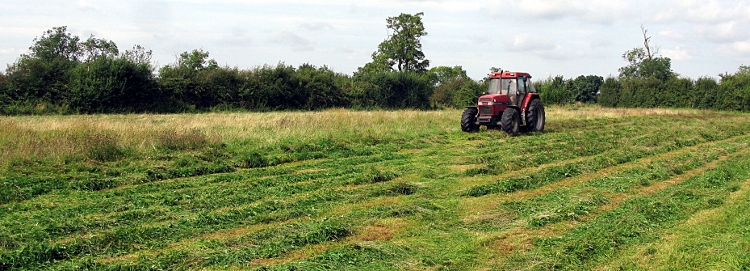
25th August, Saturday, Walking through the reserve, I disturbed a flock of about 30 Goldcrests, who were feeding on the seed heads of the Knapweed. They took flight, circled around to a nearby hedge and watched, waiting I presume to resume their feeding when I had gone. I also saw a Small Copper butterfly, the first and only one I have seen this year.
Walking near the pond I noticed that none of the holes in the logs nailed to the fence, seem to be occupied by Nesting Bee eggs, whereas they were last year.
There is a new plant in the pond, a couple of Skullcaps, and the Purple Loosestrife is in flower now. The Skullcap is one of the flower that were planted last autumn.
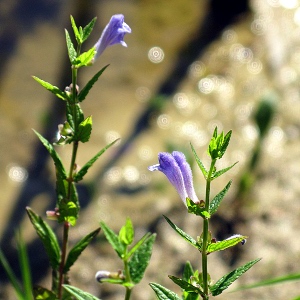
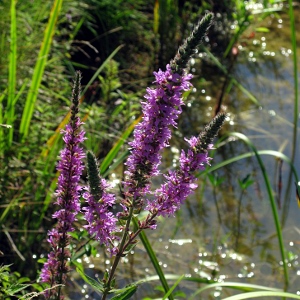
18th August, Saturday, Near the path through the reserve are many Autumn Hawkbit, shown below.
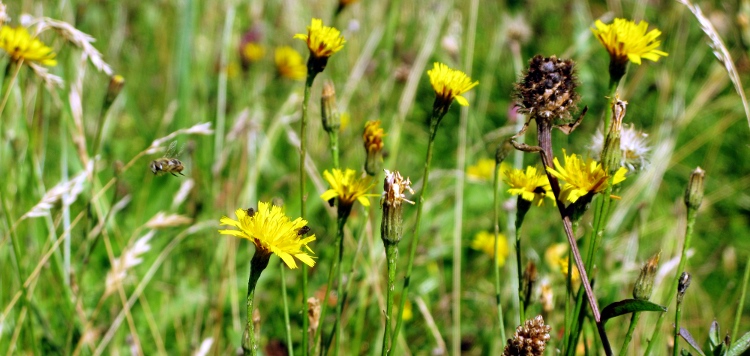
In the first field next to the Rec, at the far end are examples of Greater Birds Foot Trefoil, below left, and Burnet Saxifrage, below right.
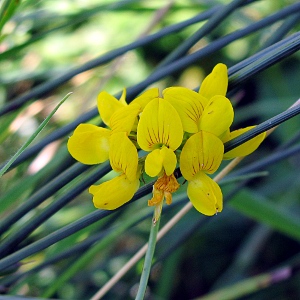
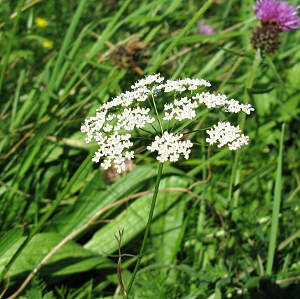
Also in this area a Devil's Bit Scabious has started to flower below left, it looks much like the Feild Scabious to me, of which there are quite a few, except the flower may be smaller, but the way to tell is to look at the leaves, the field scabious is the upper compound leaf, while the devil's bit scabious has a plain or simple leaf shown lower below right.
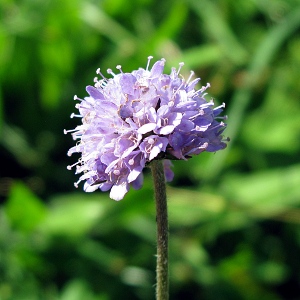
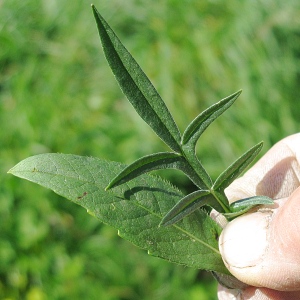
There is activity at the pond, with several dragonflies buzzing about, and one laying eggs as shown below left. There have also been dragonflies in our garden, and I have seen several at other locations around the village. In the hot sunshine, the buzz of grasshoppers could be heard, and one poor fellow had hopped into the pond, below right, where a water boatman, that scavenger of the pond, is just about to attack and eat it.
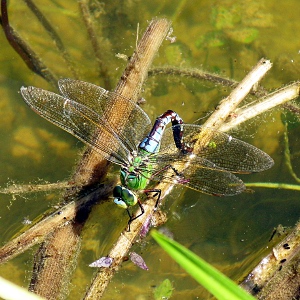
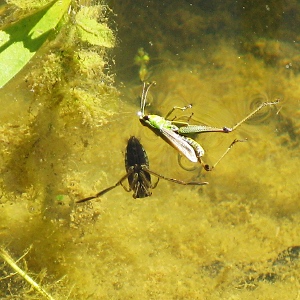
11th August, Saturday, A really nice day, not too warm, to walk around the Reserve, and hear the chirping grasshoppers, and watch the butterflies and insects around the flowers.
After not seeing many butterflies all summer at last the warmer weather has encouraged a few out. Below left is a Marbled White feeding on a Feild Scabious flower, and on the right a Meadow Brown of which there were quite a few to be seen.
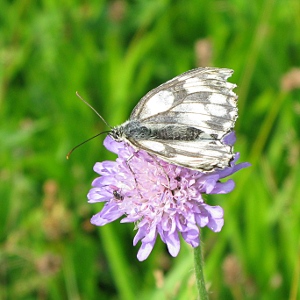
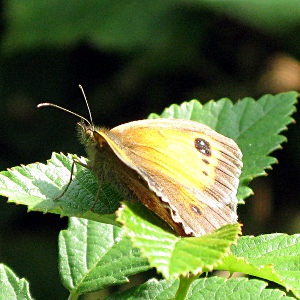
A Hawkbit flower was covered with what look like flies to me ( below left), and on a nearby Knapweed bud there was a green bug, a Capsid bug, which is thought of as a real pest in gardens, ( below right).
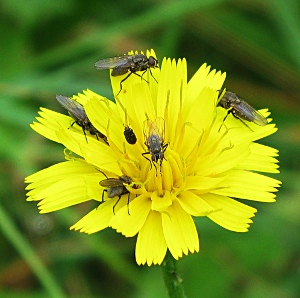
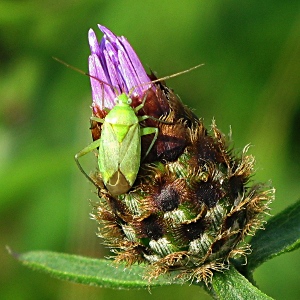
Also feeding on the Knapweed flowers, were a Hover fly ( below left), and a Bee, (below right).
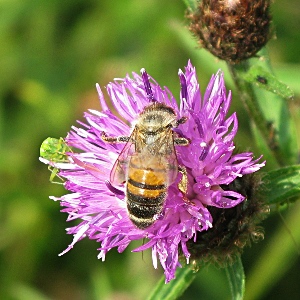
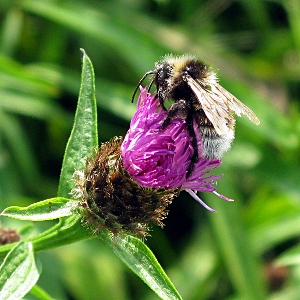
A bit further on, I managed to photograph a slightly different type of Hover fly, doing what Hover flies do, hovering. In this case I think these must be male and female, as the one in flight was paying a lot of attention to the one on the flower.
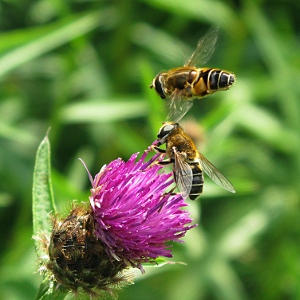
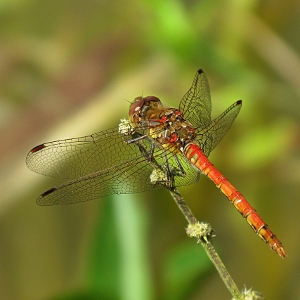
At the pond, which has lost a few inches of water in the drier conditions, I spotted a dragonfly, which landed on a branch nearby and allowed me to take several photos. Looks from the wing pattern like a Four Spot Chaser again, but this time a brightly coloured one rather than the drab brown one I saw a month or so ago.
From the internet this one is called a Ruddy Darter, its a male, and the Ruddy describes the colour. Moments later it was hooked up in flight with a brown dragonfly, so presumably the female is a brown colour, and they were using the pond and surrounds to lay their eggs.
4th August, Saturday, A day of sunny periods and showers, and it has been warmer and sunnier for the last week or so, but with rain showers.
Warning, beware of the biting insects, which attacked while I was taking photographs, well I suppose you have to suffer for your art.
The Spiny Restharrow is now in flower below left, and is to be seen on a few ridges at the far end of the field next to the Rec. As are several Scabious, Feild Scabious I think, shown below right.
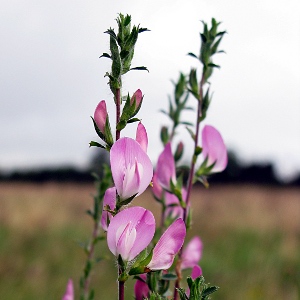
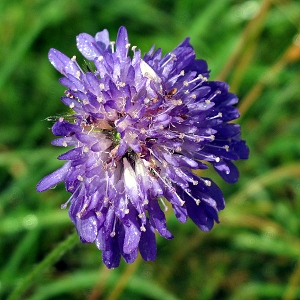
Around the pond the Purple Loosestrife is now in flower, below left, as are the Blackberry bushes nearby shown below right.
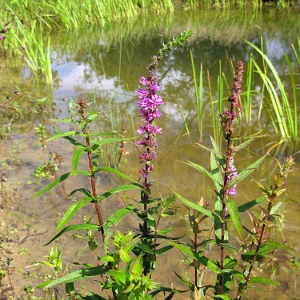
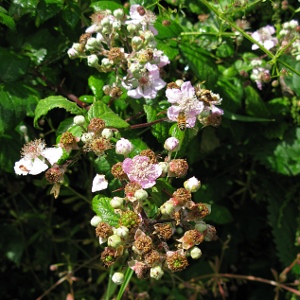
I also found a couple of plants which are difficult to identify exactly, especially the one shown below left, which is a Cats ear, or Nipplewort, and its not quite like the pictures in the book. The one on the right below is thought to be a Hedge Bedstraw, a relative of the Lady's Bedstraw, of which there is a lot in the Reserve.
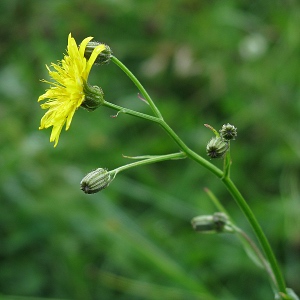
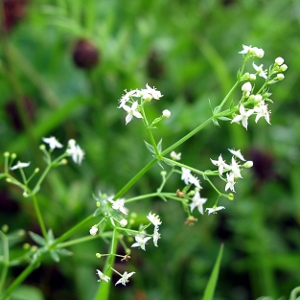
And finally close to the path through the Reserve is what looks like more cow parsley, but is Wild Carrot (below).
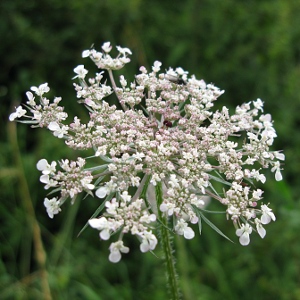
The fields will be mown for hay probably at the end of the month, so August will be the last month to be able to visit and see the flowers that are there this year.
21st July, Saturday, after 14 inches of rain in the last 14 weeks, it seems the weather may be about to change, with the jet stream which has brought us all this rain, forecast to move further north and bring us warmer weather. Today was warm and sunny, and its forecast to get even warmer over the next few days.
The Knapweed is in flower now and at its best, most of the Buttercups are long gone with just a few hanging on, the Yellow Rattle didn't grow very well this year, and the grass is very lush.
A few Meadow brown butterflies are about, but otherwise it has beed a very bad year for butterflies so far, with very few seen in village gardens which have plenty of flower to attract them.
Another Campion has come into flower, which looks a little diferent to the one seen in June, they are shown below, and on careful checking it seems the one seen last month is actually a White Campion, below left, while the new one is a Bladder Campion, below right.
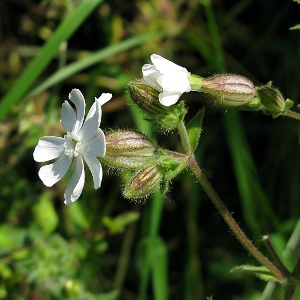
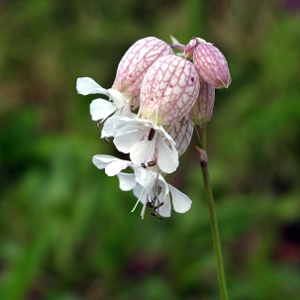
Field Scaboius (below left) is in flower in a few places in the field next to the Rec, as is Great Burnet (below right) a rather odd looking flower on a long stem, which does have quite a lot of foliage close to the ground.
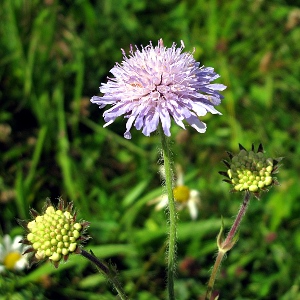
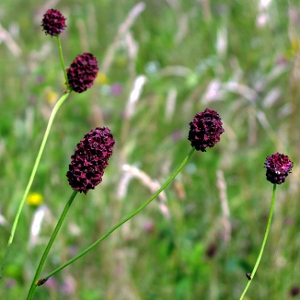
A couple of the Vetches are in flower, below left shows the Yellow Meadow Vetchling, which can be seen in various places, and on the right below is the Tufted Vetch, looking rather like a blue toothbrush.
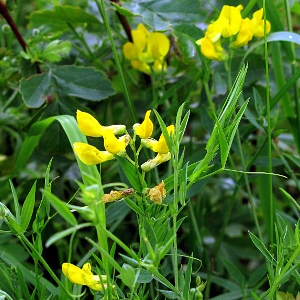
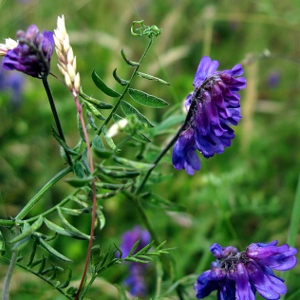
One flower you cannot miss as it is everywhere in the reserve, is the Knapweed show below left, notice that it grows on the top of the ridges, where it is slightly dryer, whilst the Meadowsweet, ( below right) prefers damper conditions and is found in the wetter dips between the ridges. The ridges are a survival of the middle ages when fields were divided into narrow strips and cultivated by ploughing along one side of each strip, and then back along the otherside, thus forming a ridge, it is uncertain why they did this, but it probaby helped drain the fields before the introduction of mole drains.
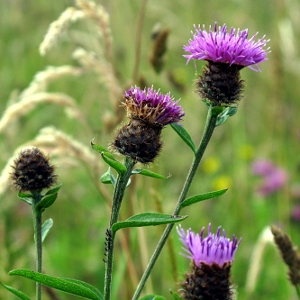
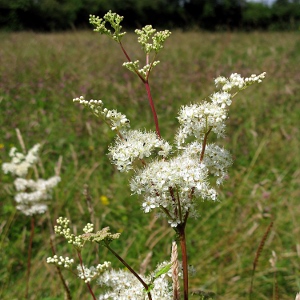
1st July, Sunday, 25 people came to the Reserve this morning to take part in the walk led by Matt Dodds, the Aylesbury Vale Biodiversity Officer. As well as talking about the flowers, grasses, and shrubs in the reserve, Matt pointed out that flower meadows don't just grow, like all of the English countryside, they are managed in some way or other. And without the management which was done to provide food for animals, it would be taken over by tall grasses, and gradually revert to Oak woodland.
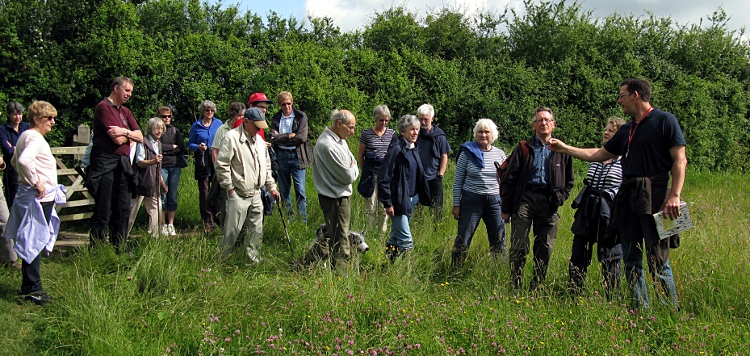
Read the News from June 2012
Read the news from May 2012
Read the news from April 2012
Read the news from January to March 2012
Read the news from October to December 2011
Read the news from September2011
Read the news from August 2011
Read the news from July 2011
Read the news from June 2011
Read the news from May 2011
Read the news from April 2011
Read the news from March 2011
Read the news from January and February 2011
Read the news notes from 2010
31st August, Saturday, was a nice warm day to cut the hay.

25th August, Saturday, Walking through the reserve, I disturbed a flock of about 30 Goldcrests, who were feeding on the seed heads of the Knapweed. They took flight, circled around to a nearby hedge and watched, waiting I presume to resume their feeding when I had gone. I also saw a Small Copper butterfly, the first and only one I have seen this year.
Walking near the pond I noticed that none of the holes in the logs nailed to the fence, seem to be occupied by Nesting Bee eggs, whereas they were last year.
There is a new plant in the pond, a couple of Skullcaps, and the Purple Loosestrife is in flower now. The Skullcap is one of the flower that were planted last autumn.


18th August, Saturday, Near the path through the reserve are many Autumn Hawkbit, shown below.

In the first field next to the Rec, at the far end are examples of Greater Birds Foot Trefoil, below left, and Burnet Saxifrage, below right.


Also in this area a Devil's Bit Scabious has started to flower below left, it looks much like the Feild Scabious to me, of which there are quite a few, except the flower may be smaller, but the way to tell is to look at the leaves, the field scabious is the upper compound leaf, while the devil's bit scabious has a plain or simple leaf shown lower below right.


There is activity at the pond, with several dragonflies buzzing about, and one laying eggs as shown below left. There have also been dragonflies in our garden, and I have seen several at other locations around the village. In the hot sunshine, the buzz of grasshoppers could be heard, and one poor fellow had hopped into the pond, below right, where a water boatman, that scavenger of the pond, is just about to attack and eat it.


11th August, Saturday, A really nice day, not too warm, to walk around the Reserve, and hear the chirping grasshoppers, and watch the butterflies and insects around the flowers.
After not seeing many butterflies all summer at last the warmer weather has encouraged a few out. Below left is a Marbled White feeding on a Feild Scabious flower, and on the right a Meadow Brown of which there were quite a few to be seen.


A Hawkbit flower was covered with what look like flies to me ( below left), and on a nearby Knapweed bud there was a green bug, a Capsid bug, which is thought of as a real pest in gardens, ( below right).


Also feeding on the Knapweed flowers, were a Hover fly ( below left), and a Bee, (below right).


A bit further on, I managed to photograph a slightly different type of Hover fly, doing what Hover flies do, hovering. In this case I think these must be male and female, as the one in flight was paying a lot of attention to the one on the flower.


At the pond, which has lost a few inches of water in the drier conditions, I spotted a dragonfly, which landed on a branch nearby and allowed me to take several photos. Looks from the wing pattern like a Four Spot Chaser again, but this time a brightly coloured one rather than the drab brown one I saw a month or so ago.
From the internet this one is called a Ruddy Darter, its a male, and the Ruddy describes the colour. Moments later it was hooked up in flight with a brown dragonfly, so presumably the female is a brown colour, and they were using the pond and surrounds to lay their eggs.
4th August, Saturday, A day of sunny periods and showers, and it has been warmer and sunnier for the last week or so, but with rain showers.
Warning, beware of the biting insects, which attacked while I was taking photographs, well I suppose you have to suffer for your art.
The Spiny Restharrow is now in flower below left, and is to be seen on a few ridges at the far end of the field next to the Rec. As are several Scabious, Feild Scabious I think, shown below right.


Around the pond the Purple Loosestrife is now in flower, below left, as are the Blackberry bushes nearby shown below right.


I also found a couple of plants which are difficult to identify exactly, especially the one shown below left, which is a Cats ear, or Nipplewort, and its not quite like the pictures in the book. The one on the right below is thought to be a Hedge Bedstraw, a relative of the Lady's Bedstraw, of which there is a lot in the Reserve.


And finally close to the path through the Reserve is what looks like more cow parsley, but is Wild Carrot (below).

The fields will be mown for hay probably at the end of the month, so August will be the last month to be able to visit and see the flowers that are there this year.
21st July, Saturday, after 14 inches of rain in the last 14 weeks, it seems the weather may be about to change, with the jet stream which has brought us all this rain, forecast to move further north and bring us warmer weather. Today was warm and sunny, and its forecast to get even warmer over the next few days.
The Knapweed is in flower now and at its best, most of the Buttercups are long gone with just a few hanging on, the Yellow Rattle didn't grow very well this year, and the grass is very lush.
A few Meadow brown butterflies are about, but otherwise it has beed a very bad year for butterflies so far, with very few seen in village gardens which have plenty of flower to attract them.
Another Campion has come into flower, which looks a little diferent to the one seen in June, they are shown below, and on careful checking it seems the one seen last month is actually a White Campion, below left, while the new one is a Bladder Campion, below right.


Field Scaboius (below left) is in flower in a few places in the field next to the Rec, as is Great Burnet (below right) a rather odd looking flower on a long stem, which does have quite a lot of foliage close to the ground.


A couple of the Vetches are in flower, below left shows the Yellow Meadow Vetchling, which can be seen in various places, and on the right below is the Tufted Vetch, looking rather like a blue toothbrush.


One flower you cannot miss as it is everywhere in the reserve, is the Knapweed show below left, notice that it grows on the top of the ridges, where it is slightly dryer, whilst the Meadowsweet, ( below right) prefers damper conditions and is found in the wetter dips between the ridges. The ridges are a survival of the middle ages when fields were divided into narrow strips and cultivated by ploughing along one side of each strip, and then back along the otherside, thus forming a ridge, it is uncertain why they did this, but it probaby helped drain the fields before the introduction of mole drains.


1st July, Sunday, 25 people came to the Reserve this morning to take part in the walk led by Matt Dodds, the Aylesbury Vale Biodiversity Officer. As well as talking about the flowers, grasses, and shrubs in the reserve, Matt pointed out that flower meadows don't just grow, like all of the English countryside, they are managed in some way or other. And without the management which was done to provide food for animals, it would be taken over by tall grasses, and gradually revert to Oak woodland.

Read the News from June 2012
Read the news from May 2012
Read the news from April 2012
Read the news from January to March 2012
Read the news from October to December 2011
Read the news from September2011
Read the news from August 2011
Read the news from July 2011
Read the news from June 2011
Read the news from May 2011
Read the news from April 2011
Read the news from March 2011
Read the news from January and February 2011
Read the news notes from 2010
